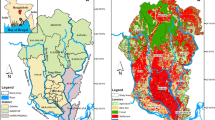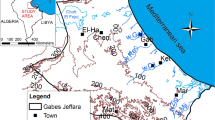Abstract
The Wadi Araba Basin is a desert area in which finding water represents a real challenge. One potential source for the abstraction of groundwater is a sandstone aquifer which is partly covered by alluvial sediments distributed along the Wadi Araba Valley. The study analyses the impacts of abstraction and climate changes on groundwater quantity. It also aims to define a safe yield for the groundwater resources and to locate new wellfields in hydrogeological areas that will minimize high drawdown. Numerical modelling (MODFLOW NWT version) was applied in order to develop a regional groundwater flow model for the Wadi Araba Basin. The modelling area covers 6268 km2 (the Wadi Araba Basin on the Jordanian side). The cell sizes in horizontal directions are 500 m, and there are four layers in a vertical direction represented by the main aquifers and aquitards of the hydrogeological system (alluvial aquifer, A7/B2 carbonate aquifer, A1-A6 marly aquitard and Kb/Ram sandstone aquifer). Results of the modelling show that renewable groundwater resources stand at around 20 million cubic meters per year (MCM/year). According to the most pessimistic predictive scenario, the water table might decrease by 60 m by 2050, with the most optimistic scenario putting that figure at 24 m. Five new wellfield locations are proposed (four in the central part and one in the northern part of the Wadi Araba Valley). According to the model, the opening of new wellfields in these optimal locations, and the closing of some old wells where relatively large drawdowns were recorded, revealed that a more sustainable abstraction of groundwater could be achieved.







Similar content being viewed by others
References
Abdulaziz AM, Faid AM (2015) Evaluation of the groundwater resources potential of Siwa Oasis using three-dimensional multilayer groundwater flow model, Mersa Matruh governorate, Egypt. Arab J Geosci 8(2):659–675. https://doi.org/10.1007/s12517-013-1199-4
Al-Farajat M (2001) Hydrogeo-eco-systems in Aqaba/Jordan–coasts and region; natural settings, impacts of land use, spatial vulnerability to pollution and sustainable management. Dissertation, University of Würzburg
Alkhatib J, Engelhardt I, Ribbe L, Sauter M (2019) An integrated approach for choosing suitable pumping strategies for a semi-arid region in Jordan using a groundwater model coupled with analytical hierarchy techniques. Hydrogeol J 27:1143–1157
Al-Maktoumi A, Zekri S, El-Rawy M, Abdalla O, Al-Wardy M, Al-Rawas G, Charabi Y (2018) Assessment of the impact of climate change on coastal aquifers in Oman. Arab J Geosci 11. https://doi.org/10.1007/s12517-018-3858-y
Aquaveo (2018) GMS (Groundwater Modeling System). http://www.xmswiki.com/wiki/GMS:GMS. Accessed 26 November 2018
Barthelemy Y, Buscarlet E (2010) Jordan aquifers modelling project, hydrogeological synthesis, intermediary report no 2, BRGM/RC-58557-FR. Ministry of water and irrigation (Jordan), BRGM, Amman
Barthelemy Y, Buscarlet E, Gomez E, Janjou D, Klinka T, Lasseur E, Le Nindre YM, Wuilleumier A (2010) Jordan aquifers modelling project, final report, BRGM/RC-59281-FR. Ministry of water and irrigation (Jordan), BRGM, Amman
Benfetta H, Ouadja A (2020) Groundwater overuse in arid areas: case study of syncline Bouguirat-Mostaganem. Algeria Arab J Geosci 13. https://doi.org/10.1007/s12517-020-05765-1
Berhail S (2019) The impact of climate change on groundwater resources in northwestern Algeria. Arab J Geosci 12. https://doi.org/10.1007/s12517-019-4776-3
Bhakar P, Singh AP (2019) Groundwater quality assessment in a hyper-arid region of Rajasthan, India. Nat Resour Res 28:505–522. https://doi.org/10.1007/s11053-018-9405-4
Bosompemaa P, Yidana SM, Chegbeleh LP (2016) Analysis of transient groundwater flow through a stochastic modelling approach. Arab J Geosci 9. https://doi.org/10.1007/s12517-016-2733-y
Boufekane A, Saibi H, Benlaoukli B, Saighi O (2019) Scenario modeling of the groundwater in a coastal aquifer (Jijel plain area, Algeria). Arab J Geosci 12. https://doi.org/10.1007/s12517-019-4965-0
Charalambous AN (2016) The fossil Ram sandstone aquifer of Jordan: hydrogeology, depletion and sustainability. Q J Eng Geol Hydrogeol 49:76–91. https://doi.org/10.1144/qjegh2015-060
COYNE-ET BELLIER (2011) Red Sea–red seawater conveyance study program draft final feasibility study report (12 147 RP 04), appendix F–geosciences report. COYNE-ET BELLIER in association with TRACTEBEL ENGINEERING and KEMA, Amman
El-Kadi AI, Tillery S, Whittier RB, Hagedorn B, Mair A, Ha K, Koh G (2014) Assessing sustainability of groundwater resources on Jeju Island, South Korea, under climate change, drought, and increased usage. Hydrogeol J 22(3):625–642. https://doi.org/10.1007/s10040-013-1084-y
El-Naqa A, Al Kuisi M (2013) Groundwater resources assessment for irrigable agricultural lands in the Wadi Araba area, southern Jordan. Arab J Geosci 6(8):3027–3039. https://doi.org/10.1007/s12517-012-0579-5
Energoprojekt (1989) Wadi Araba deevelopment project, interim report, book 1: Main hydrogeological report. Energoproject CO, Jafar Tukan & Partners, Belgrade
Energoprojekt (1990) Wadi Araba Deevelopment project, final Hydrogeologycal study, book 3 basic hydrogeological data. Energoproject CO, Jafar Tukan & Partners, Belgrade
Harbaugh A (2005) MODFLOW-2005, the U.S. geological survey modular ground-water model: the ground-water flow process. Techniques and methods 6 (A16, US geological survey, Reston, VA
HKO (2017) Groundwater modeling and simulation of Wadi Araba aquifers, under the project for developing the Wadi Araba integrated development master plan. Ministry of water and irrigation (Jordan), HS, KEIOS & ORIENT in association with iPlan Jo, Amman
Hobler M, Bender H, Rashdan J, Schmidt G (1991) groundwater resources of southern Jordan, report of the projects 86.2068.4 and 88.2180.3. Bundesanstalt für Geowissenschaften und Rohstoffe (BGR), Amman
Krešić N (2007) Hydrogeology and groundwater Modelling. CRC Press, Taylor & Francis Group, Boca Raton
Margane A, Hobler M, Almomani M, Subah A (2002) Contributions to the hydrogeology of northern and Central Jordan. Geologisches Jahrbuch, C68, Hannover
McDonald MG, Harbaugh AW (1988) A modular three-dimensional finite-diffe rence ground-water flow model. Techniques of water-resources investigations of the USGS. (book 6, chapter A1). U. S. geological survey, USA
NASA (2011) Advanced spaceborne thermal emission and reflection radiometer (ASTER), global digital elevation model version 2 (GDEM V2). The National aeronautics and space administration, Washington
Nassery H, Salami H (2016) Identifying vulnerable areas of aquifer under future climate change (case study: Hamadan aquifer, West Iran). Arab J Geosci 9. https://doi.org/10.1007/s12517-016-2526-3
Nindre YL, Lasseur E (2010) Jordan aquifers modelling project, intermediary report no 1, 3D geological model, BRGM/RC-58556-FR. Ministry of water and irrigation (Jordan), BRGM, Amman
Niswonger RG, Panday S, Ibaraki M (2011) MODFLOW-NWT: a Newton formulation for MODFLOW-2005. US Geol Surv Tech Methods 6-A37, 44 pp
NWMP (2018) National Water Master Plan of Jordan. Natural resources Authority of Jordan (NRA) and German Agency for Technical Cooperation (GTZ), Amman
Ouhamdouch S, Bahir M, Ouazar D, Goumih A, Zouari K (2020) Assessment the climate change impact on the future evapotranspiration and flows from a semi-arid environment. Arab J Geosci 13. https://doi.org/10.1007/s12517-020-5065-x
Rödiger T, Magri F, Geyer S, Morandage ST, Subah HEA, Alraggad M, Siebert C (2017) Assessing anthropogenic impacts on limited water resources under semi arid conditions: three-dimensional transient regional modelling in Jordan. Hydrogeol J 25:2139–2149
Salameh E, Abdallat G, van der Valk M (2019) Planning considerations of managed aquifer recharge (MAR) projects in Jordan. Water 11(2):182. https://doi.org/10.3390/w11020182
Sekulić G, Radulović MM (2016) Modeling of hydrogeological processes in the Zeta plain, catchment area of Lake Skadar in Montenegro. Water Res Manag 6(3):13–21
Shrestha S, Bach TV, Pandey VP (2016) Climate change impacts on groundwater resources in Mekong Delta under representative concentration pathways (RCPs) scenarios. Environ Sci Pol 61:1–13. https://doi.org/10.1016/j.envsci.2016.03.010
Singh AP, Bhakar P (2020) Development of groundwater sustainability index: a case study of western arid region of Rajasthan, India. Environ Dev Sustain. https://doi.org/10.1007/s10668-020-00654-9
SWK (1998) Study of Wadi Araba Deep Aquifers, Final Report. Ministry of Water and Irrigation, Jordan Valley Authority, Scott Wilson Kirkpatrick in association with SEYAS and Jouzy & Partners, Amman
White EK, Costelloe J, Peterson TJ, Western AW, Carrara E (2019) Do groundwater management plans work? Modelling the effectiveness of groundwater management scenarios. Hydrogeol J 27(7):2447–2470. https://doi.org/10.1007/s10040-019-02004-0
Whitman E (2019) A land without water: the scramble to stop Jordan from running dry. Nature 573:20–23. https://doi.org/10.1038/d41586-019-02600-w
WIS (2016) Water information system. Ministry of water and irrigation (Jordan), Amman
Woldeamlak ST, Batelaan O, De Smedt F (2007) Effects of climate change on the groundwater system in the Grote-Nete catchment, Belgium. Hydrogeol J 15(5):891–901. https://doi.org/10.1007/s10040-006-0145-x
WRMMP (2002) The study on water resources management in the Hashemite Kingdom of Jordan, final report volume I, main report part-a, water resources management master plan. Ministry of water and irrigation (Jordan), Amman
Yidana SM, Addai MO, Asiedu DK, Banoeng-Yakubo B (2016) Stochastic groundwater modeling of a sedimentary aquifer: evaluation of the impacts of abstraction scenarios under conditions of reduced recharge. Arab J Geosci 9. https://doi.org/10.1007/s12517-016-2718-x
Acknowledgements
We are extremely grateful to individuals from companies (Orient Engineering Consultancy from Jordan, HS & Associates from Jordan and Keios Development Consulting from Italy) that provided us with all the necessary conditions for effective research in the Wadi Araba Basin.
Author information
Authors and Affiliations
Corresponding author
Additional information
Responsible Editor: Broder J. Merkel
Rights and permissions
About this article
Cite this article
Radulovic, M.M., Wong, H. & Al Tarawneh, M. Groundwater flow modelling for an assessment of abstraction and climate change impacts on groundwater resources—an example from the Wadi Araba Basin (Jordan). Arab J Geosci 13, 1142 (2020). https://doi.org/10.1007/s12517-020-06148-2
Received:
Accepted:
Published:
DOI: https://doi.org/10.1007/s12517-020-06148-2




